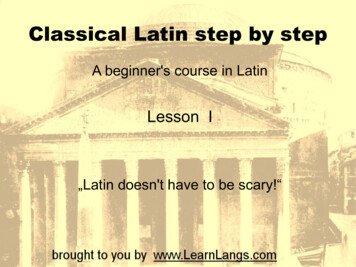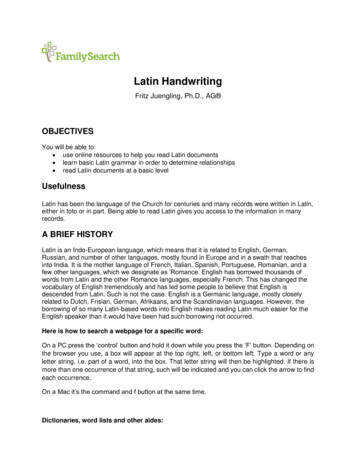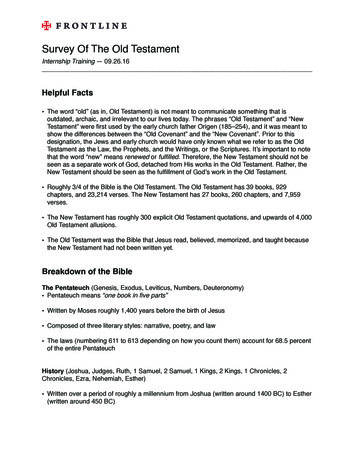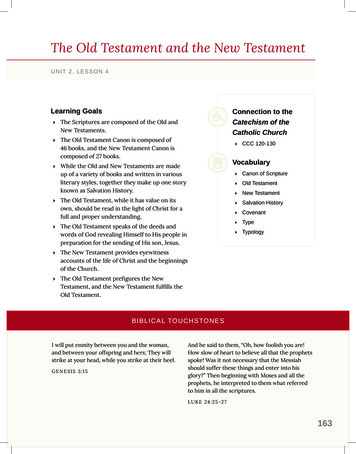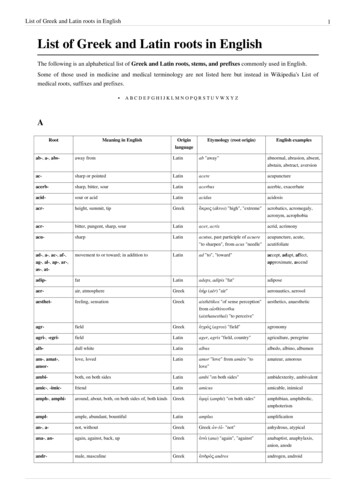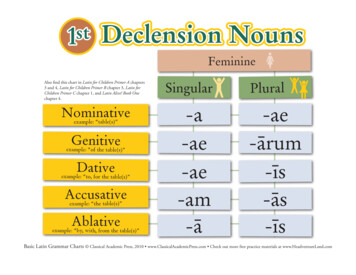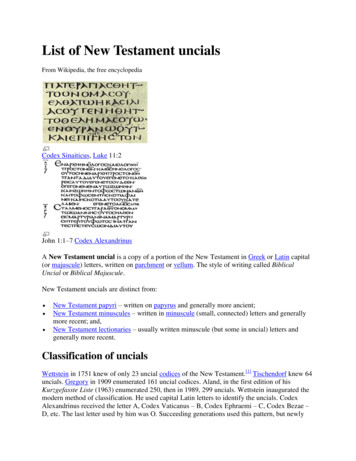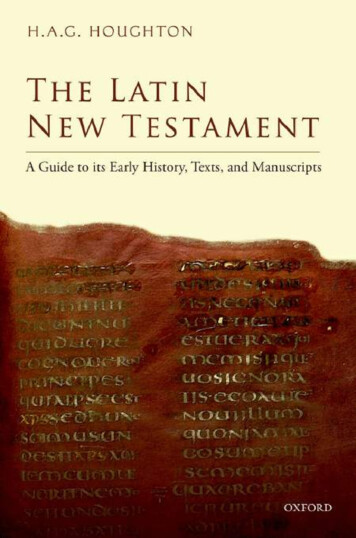
Transcription
OUP CORRECTED PROOF – FINAL, 1/12/2015, SPiTH E LATIN N EW T ESTAMENT
OUP CORRECTED PROOF – FINAL, 1/12/2015, SPi
OUP CORRECTED PROOF – FINAL, 1/12/2015, SPiThe Latin New TestamentA Guide to its Early History,Texts, and ManuscriptsH.A.G. HOUGHTON1
OUP CORRECTED PROOF – FINAL, 14/2/2017, SPi3Great Clarendon Street, Oxford, OX2 6DP,United KingdomOxford University Press is a department of the University of Oxford.It furthers the University’s objective of excellence in research, scholarship,and education by publishing worldwide. Oxford is a registered trade mark ofOxford University Press in the UK and in certain other countries H.A.G. Houghton 2016The moral rights of the authors have been assertedFirst Edition published in 2016Impression: 1Some rights reserved. No part of this publication may be reproduced, stored ina retrieval system, or transmitted, in any form or by any means, for commercial purposes,without the prior permission in writing of Oxford University Press, or as expressly permittedby law, by licence or under terms agreed with the appropriate reprographicsrights organization.This is an open access publication, available online and unless otherwise stated distributed under theterms of a Creative Commons Attribution –Non Commercial –No Derivatives 4.0International licence (CC BY-NC-ND 4.0), a copy of which is available /.Enquiries concerning reproduction outside the scope of the aboveshould be sent to the Rights Department, Oxford University Press, at theaddress abovePublished in the United States of America by Oxford University Press198 Madison Avenue, New York, NY 10016, United States of AmericaBritish Library Cataloguing in Publication DataData availableLibrary of Congress Control Number: 2015946703ISBN 978–0–19–874473–3Printed in Great Britain byClays Ltd, St Ives plcLinks to third party websites are provided by Oxford in good faith andfor information only. Oxford disclaims any responsibility for the materialscontained in any third party website referenced in this work.
OUP CORRECTED PROOF – FINAL, 1/12/2015, SPiTo David,with thanksThe research leading to these results has received funding from theEuropean Union Seventh Framework Programme (FP7/2007–2013)under grant agreement no. 283302 (COMPAUL: ‘The EarliestCommentaries on Paul as Sources for the Biblical Text’).
OUP CORRECTED PROOF – FINAL, 1/12/2015, SPi
OUP CORRECTED PROOF – FINAL, 1/12/2015, SPiPrefaceThe Latin tradition supplies some of the earliest sources for the history of theNew Testament text. Moreover the Bible was read and studied in this languagefor over a millennium by some of the world’s most influential scholars andtheologians. The manuscripts which transmit the text also provide a windowon intellectual culture, book production, and religious practice across thecenturies. Their evidence is supplemented by biblical quotations in Christiantexts from Antiquity until the Renaissance.The present volume seeks to offer an orientation to the early history of thistradition, a guide to the resources available for further study of the Latin NewTestament, and an account of its significance for the biblical text. Recentdevelopments in the field are such that the introductory chapters which haveserved for several decades are now in need of updating and expansion.1 Berger’sHistoire de la Vulgate, written well over a century ago, is often still cited as theonly monograph to cover the whole Latin Bible even though it has bothtemporal and geographical limitations. Some of the information in specialiststudies has yet to reach a wider audience. Almost all publications on the NewTestament continue to employ an outdated set of sigla for Latin manuscripts. Ina climate of renewed interest in biblical textual criticism and manuscript study,fuelled in part by the ever-increasing numbers of fully-digitized codices available on the internet, the time is ripe for a new manual which will enable furtherwork to take proper account of previous scholarship. In fact, the approachadopted here goes beyond previous surveys, largely structured around thedescription of key manuscripts, by integrating the evidence of Latin Christianwriters. This results in a more continuous historical approach, illustrating thespectrum of the development of the New Testament text in Latin.Latin versions of the Bible are often treated under the two headings of OldLatin (Vetus Latina) and Vulgate. This traditional characterization, relyingpartly on the testimony of ancient authors, presents a picture of an earlyperiod of variety and confusion which was superseded by a single authorizedversion produced around the end of the fourth century. There are numerousproblems with this account. For a start, the New Testament books of theVulgate were not a fresh translation but a revision of existing versions carried1e.g. Fischer 1972, Metzger 1977, and Elliott 1992. Several important works have appearedduring the preparation of this book, chief among which are the first two volumes of the NewCambridge History of the Bible (Carleton Paget & Schaper 2013; Marsden & Matter 2012) andvan Liere’s Introduction to the Medieval Bible (2014). The focus of the latter on a later period ofreception and exegesis, with numerous examples from the Old Testament, offers an excellentcomplement to the present undertaking.
OUP CORRECTED PROOF – FINAL, 1/12/2015, SPiviiiPrefaceout by more than one person. Jerome was only responsible for the Gospels,and even he seems to have made fewer alterations in the latter half of his work.The revised texts also took several centuries to gain acceptance, and were onlyidentified by the name ‘Vulgate’ late in their history. The Latin New Testamentis therefore a continuum in which a particular form of text eventually gainedpredominance, a situation comparable to that of the later hegemony of theByzantine ‘Majority’ text in the Greek tradition. What is more, readings fromancient forms persist in later Latin manuscripts and Christian authors, resulting in the phenomenon of ‘mixed texts’ bearing witness to a greater or lesserextent of ‘contamination’ in the textual tradition. Secondly, the early multiplicity of Latin translations has become much more difficult to sustainfollowing work on the monumental Vetus Latina edition in the latter half ofthe twentieth century. For each of the books which has so far appeared, bothOld and New Testament, the evidence appears to point towards a single Latinversion standing behind the whole of the surviving tradition.2 This is not tosay that there were not multiple independent translations in the earliest times,but if this were the case then they have left few, if any, traces. The varietybetween the different forms of text which have been preserved can beexplained as the result of numerous later interventions, some one-off orhaphazard, others more consistent, revising a Latin version in order to bringit into accordance with a Greek source or the canons of grammar and style.The overall direction in the creation of the Vulgate is the elimination ofparaphrase towards the goal of formal equivalence with whichever Greekform was adopted as a standard. Attempts to identify certain earlier textualforms as ‘African’, ‘Italian’, or ‘European’ have largely been abandoned, alongwith the designation of the Old Latin texts as Itala. The long period duringwhich different Latin texts circulated and influenced each other often makes itdifficult to distinguish between different strands. The Vulgate tradition itself,too, is not monolithic. Nevertheless, the relative stability of the fifth-centuryrevision and the existence of a widely-accepted critical text in the form of theStuttgart Vulgate makes it simple in practical terms to use this as a measureagainst which to define differing Latin New Testament traditions. In thepresent volume, ‘pre-Vulgate’ is used as a synonym for ‘Old Latin’ where aform is attested prior to the fifth century; ‘non-Vulgate’ simply indicates areading which differs from the editorial text of the Stuttgart Vulgate regardlessof the period at which it may have arisen.There are three parts to this book. Part I is a historical overview of evidencefor the Latin New Testament focusing on the Old Latin tradition, whichbroadly covers the first millennium. This survey brings together details aboutthe use of the Bible and the development of the text from a variety of sources,2See pages 12–14.
OUP CORRECTED PROOF – FINAL, 1/12/2015, SPiPrefaceixincluding observations in Christian authors, their exegetical writings and thetextual affiliation of their scriptural quotations, and the New Testament manuscripts surviving from this period. The account is broadly chronological, butalso ordered by geographical area: manuscripts are generally mentioned at thepoint at which they were copied, although in some cases their text may reachback far earlier. Reference is therefore also made to the Vetus Latina text-types.Part II consists of a guide to the principal resources currently available forresearch into the text or history of the Latin New Testament, followed by anaccount of the place of Latin within the wider textual history of these writings.Each of the five sections of the New Testament (Gospels, Pauline Epistles,Acts of the Apostles, Catholic Epistles, and Revelation) is considered in turn,with details of the main witnesses and the contribution of Latin evidence inselected readings or passages. Part III focuses on manuscripts. After a summaryof features found in Latin biblical manuscripts, explaining different paratextualelements and trends in book production, a catalogue is given of the major LatinNew Testament manuscripts. The list comprises all witnesses featuring in theNew Testament part of the register maintained by the Vetus Latina Institute inBeuron, which oversees the publication of the earliest Latin evidence, and themain manuscripts in the two principal editions of the Vulgate, the StuttgartVulgate of Weber, Gryson, et al. and the Oxford Vulgate of Wordsworth,White, et al. An internet address has been provided for complete or substantialsets of digitized images made available online, usually by the holding institution. There is an extensive bibliography, which permits references to secondaryliterature in the body of the text to be kept as short as possible.In the absence of a single authoritative list of Latin New Testament manuscripts comparable to the Gregory-Aland Kurzgefasste Liste for Greek NewTestament manuscripts, referencing is always an issue.3 In Part I, I have ingeneral used the customary Latin names for biblical codices along with astandard siglum. For Old Latin witnesses the sigla follow the Vetus Latinasystem, consisting of VL followed by a number. For Vulgate manuscripts,I have created a siglum based on the edition and, where necessary, the sectionof the New Testament in which it is cited, but using only the minimalinformation required to differentiate witnesses. This consists of the letters‘Vg’, a superscript capital S or O for the Stuttgart or Oxford editions respectively and a superscript lower-case letter for the five sections of New Testamentmentioned above (e p a c r), followed by the alphabetic siglum used in thatedition at that point. Thus ‘Vg F’ will always be Codex Fuldensis, since F isused in both the Stuttgart and Oxford Vulgates for Codex Fuldensis throughout the New Testament; ‘VgSp R’ indicates manuscript R in the PaulineEpistles section of the Stuttgart Vulgate, which must be distinguished from3A database is currently being compiled at Birmingham which, it is hoped, will form the basisof such a catalogue.
OUP CORRECTED PROOF – FINAL, 1/12/2015, SPixPrefacethe different manuscript R used in this edition for the Catholic Epistles (‘VgSc R’).Although slightly cumbersome, this system is transparent and means thatreference can immediately be made to the relevant entry in the Catalogue ofManuscripts (Chapter 10), where further information is provided includingother sigla which identify that manuscript. A table of concordances betweendifferent editions is provided as Appendix 1, which also includes the alphabetic sigla used for the Old Latin manuscripts. When treating Christianauthors and works, the Vetus Latina abbreviations have been supplied inbrackets. This is the most economical system of referring to Latin Christianwritings, and is laid out in full in the Vetus Latina Repertorium (Gryson2007); unless otherwise indicated, patristic texts have been cited from thecritical edition listed therein.4A handbook like this relies heavily on previous scholarly work, especiallycritical editions and catalogues. Chief among these are the resources producedby the Vetus Latina Institute, many by its pioneering and indefatigabledirectors: Bonifatius Fischer (1945–73), Hermann Josef Frede (1973–98),and Roger Gryson (1998–2013). Without their remarkable contribution tobiblical scholarship, this book could not have been written. Ongoing researchon the Latin Bible is charted in the Bulletin de la Bible latine, which appears atregular intervals in the Revue bénédictine: since 1964 this has been edited byPierre-Maurice Bogaert, whose encyclopaedic knowledge and sound judgement are to be seen in the accompanying comments. The Catalogue ofManuscripts in the present volume is based on the comparison of a numberof different sources, most of which exhibit minor discrepancies: where possible, these have been resolved through reference to the original. The VetusLatina Register (Gryson 1999) and Repertorium (Gryson 2007) have beentaken as authoritative in questions of chronology. In addition to the linksand online resources mentioned in this book, a number of associated resourcesmay be found at www.vetuslatina.org and I also hope to provide correctionsand updates at https://sites.google.com/site/haghoughton/lnt : readers areencouraged to bring any such suggestions to my attention. This is an excitingtime to be working in the field of textual scholarship, with the advent of digitalmedia offering greater access than ever before to primary documents, and thesituation is changing rapidly even in so well-established a field as the LatinNew Testament.Another of the benefits of the electronic age has been the potential forimproved collaboration. It has been an honour and a pleasure to work withdistinguished scholars on a variety of projects, and I would like in particular tothank colleagues on the International Greek New Testament Project and at theInstitute for Textual Scholarship and Electronic Editing at the University of4An explanation of the system is given on pages 118–19. A list of the author sigla may bedownloaded from www.vetuslatina.org .
OUP CORRECTED PROOF – FINAL, 1/12/2015, SPiPrefacexiBirmingham. The writing of this book was undertaken as part of my leadership of the COMPAUL project investigating the earliest commentaries on Paulas sources for the biblical text, funded by the European Research Council: I amglad to acknowledge their financial support, as well as that of the UK Arts andHumanities Research Council for other activities including my doctoral workand the Vetus Latina Iohannes. My team members Christina Kreinecker,Rosalind MacLachlan, Catherine Smith, Susan Griffith, and David Parkerdeserve a special tribute. Several of them were kind enough to read a draft ofthe whole book as did Benjamin Haupt and Josephine Houghton: theirsuggestions have made the text considerably more user-friendly. Alba Fedeliassisted with contacting Italian libraries and publishers, and I am grateful tothe various bodies which granted permission to reproduce images of itemsfrom their collections. I should also like to express my gratitude to EdithHaynes for a collection of editions of the Latin New Testament assembled byher late husband Philip, to which I have constantly referred. Tom Perridge,Karen Raith, and the other members of Oxford University Press have beenmodels of efficiency and encouragement; thanks too to Michael Janesand Gayathri Manoharan. Among those who offered personal support andencouragement as I worked on this book, I particularly thank Josephine andPolly Houghton for ensuring that I had both the space necessary for writingand plentiful tea and cake.I would like to dedicate this book to David Parker, who showed me thatNew Testament scholarship can be a vocation and has been an advocate,example, and friend throughout my academic formation.Birmingham, Petertide 2015.
OUP CORRECTED PROOF – FINAL, 1/12/2015, SPi
OUP CORRECTED PROOF – FINAL, 1/12/2015, SPiContentsxviixixList of ImagesList of AbbreviationsPart I: History1. From the Origins to the End of the Third CenturyThe Scillitan MartyrsTertullian‘Christian Latin’Cyprian and the First Latin BiblesChristian Authors in EuropeEarly Translations of Other Works2. The Fourth Century and the Beginning of the VulgateSpain and AfricaCommentators in Italy and GaulEarly Greek–Latin Bilingual ManuscriptsNorth ItalyJerome and the Vulgate GospelsRufinus of AquileiaAugustine of HippoPelagius3. Competing Texts: The Fifth to the Seventh CenturiesEarly Italian ManuscriptsChristian Writers and Conciliar DocumentsGreeks, Goths, and AriansLectionaries and HarmoniesCassiodorusLater Italian Gospel Books and Gregory the GreatAfrica and SpainFranceIreland and Britain4. The Eighth and Ninth CenturiesBede and NorthumbriaInsular Gospel ManuscriptsMonasteries in Continental EuropeCharlemagne, Alcuin, and TheodulfOld Latin 60616465696972778186
OUP CORRECTED PROOF – FINAL, 1/12/2015, SPixivContents8991Liturgical BooksCommentaries and Harmonies5. The Tenth Century Onwards: Scholarship and HeresySpanish Pandects and LectionariesAtlantic BiblesSectarian TextsLater Gospel BooksBiblical Revisions and the Glossa OrdinariaParis BiblesHarmonies, Glosses, and the Rediscovery of Greek9696100101102104105108Part II: Texts6. Editions and Resourcesa)b)c)d)e)f)g)h)i)j)k)l)SabatierVetus LatinaJülicher, ItalaVetus Latina HispanaStuttgart VulgateOxford VulgateThe Clementine Vulgate, the Nova Vulgata, and ElectronicVulgatesLatin Evidence in Greek EditionsIndividual ManuscriptsAncillary MaterialBiblical QuotationsBibliographical Resources1131131151251271271291321341361371391427. Latin as a Witness for the Greek New Testament1438. The Text of the Early Latin New Testament154154167169176181a)b)c)d)e)GospelsActs of the ApostlesPauline EpistlesCatholic EpistlesRevelation (Apocalypse)Part III: Manuscripts9. Features of Latin New Testament Manuscriptsa)b)c)d)Material and FormatScript, Abbreviations, and PunctuationContents and ParatextDecoration187187190194204
OUP CORRECTED PROOF – FINAL, 1/12/2015, SPiContents10. Catalogue of Latin New Testament Manuscriptsa) The Vetus Latina Registerb) Manuscripts in the Stuttgart Vulgatec) Manuscripts in the Oxford Vulgatexv209210254267AppendicesAppendix 1: Concordances of Manuscript Siglaa) Old Latinb) Vulgate283283285Appendix 2: Additional Manuscripts Cited in Vetus Latina Editions291Appendix 3: Additional Gospel Manuscripts295Bibliography297Index of Manuscripts345Index of Biblical Passages351Index of Ancient Authors and Writings355Index of Subjects359
OUP CORRECTED PROOF – FINAL, 1/12/2015, SPi
OUP CORRECTED PROOF – FINAL, 13/2/2017, SPiList of Images1. Map of Principal Locations.42. VL 1: Codex Bobiensis (Turin, BibliotecaNazionale Universitaria, 1163 (G.VII.15), folio 41r).233. VL 5: Codex Bezae (Cambridge, University Library,MS Nn. II.41, folios 205v–206r).294. VL 2: Codex Palatinus (Trento, Castello del Buon Consiglio,s.n., folio 49r).445. VL 8: Codex Corbeiensis (Paris, Bibliothèque nationalede France, latin 17225, folios 153v–154r).47Se6. Vg S: Codex Sangallensis 1395 (St Gall, Stiftsbibliothek1395, page 132).497. Vg F: Codex Fuldensis (Fulda, Hochschul- und Landesbibliothek,Cod. Bonif. 1, folio 149r).578. VL 14: Codex Usserianus primus (Dublin, Trinity College,MS 55, folio 77r).669. Vg A: Codex Amiatinus (Florence, Biblioteca MediceaLaurenziana, MS Amiatino 1, folio 843r).7110. VgS ΦG: Codex Grandivallensis (London, British Library,MS Add. 10546, folios 441v–442r).8311. VL 109/Vg X: Codex Complutensis primus (Madrid, BibliotecaHistórica, Universidad Complutense, BH MSS 31, folio 326r).Image courtesy of the Hill Museum & Manuscript Library.9812. Book of Deer (Cambridge, University Library, MS Ii.VI.32,folio 83r).10313. An early Paris Bible (Paris, Bibliothèque nationalede France, latin 14233, folio 306r).10714. The Vetus Latina Edition (VL 25/1, ed. H.J.Frede, page 561).122O15. Canon Tables in the Lindisfarne Gospels: Vg Y (London,British Library, MS Cotton Nero D.IV, folio 10r).20116. VL 7, Vg G: Codex Sangermanensis primus (Paris,Bibliothèque nationale de France, latin 11553, folio 164v).205* These images are not covered by the CC licence terms that govern the reuse of this publication.For permission to reuse, please contact the rights holder.
OUP CORRECTED PROOF – FINAL, 1/12/2015, SPi
OUP CORRECTED PROOF – FINAL, 1/12/2015, SPiList of AbbreviationsAbbreviations for Christian authors and their works in the Repertorium are notgiven here, although they are provided in brackets on their first occurrence in Part I.A list of authors may be downloaded from http://www.vetuslatina.org .Secondary literature is indicated by the author–date system used in theBibliography.BAVBiblioteca Apostolica VaticanaBLBritish LibraryBMBibliothèque municipaleBnFBibliothèque nationale de FranceCLACodices Latini AntiquioresCLLACodices Liturgici Latini AntiquioresGAGregory-Aland (in manuscript sigla)MSmanuscriptNANestle-Aland Novum Testamentum GraeceNA27Twenty-seventh edition (1993)NA28Twenty-eighth edition (2012)PLPatrologia LatinaUBSUnited Bible Societies’ Greek New TestamentUBS4Fourth edition (2001)UBS5Fifth edition (2014)VgVulgateVgOVgSVLOxford VulgateStuttgart VulgateVetus Latina (in manuscript sigla)Divisions of the New Testament:eGospels (Euangelia)aActs of the Apostles (Acta Apostolorum)pPauline Epistles (Epistulae Paulinae)cCatholic Epistles (Epistulae Catholicae or Epistulae Canonicae)rRevelation (Apocalypsis)
OUP CORRECTED PROOF – FINAL, 1/12/2015, SPi
OUP CORRECTED PROOF – FINAL, 30/11/2015, SPiPart IHistoryThe five chapters in this section provide an account of the historical development of the Latin New Testament from earliest times until the late MiddleAges. As an effort has been made not to duplicate information in differentparts of the book, readers may wish to refer to some of the later chapters forfurther information. Those with little or no experience of working withmanuscripts may find it helpful first of all to read Chapter 9, which providesan overview of the features and contents of Latin New Testament manuscripts.A summary of the Latin tradition for each of the New Testament writings isgiven in Chapter 8, while a detailed description of most of the manuscriptsmentioned is found in the Catalogue in Chapter 10. The abbreviations for Latinauthors and their writings are those of the Vetus Latina Repertorium describedon pages 118–19: further background information on individuals and theirworks is available on numerous websites and in encyclopaedias. Technicalterms are generally explained on their first occurrence, noted in the Index ofSubjects at the back of the book.
OUP CORRECTED PROOF – FINAL, 30/11/2015, SPi
OUP CORRECTED PROOF – FINAL, 30/11/2015, SPi1From the Origins to the Endof the Third CenturyThe origins of the Latin New Testament are unknown. No-one is explicitlyidentified as a translator or reviser of the Bible before the end of the fourthcentury. Jerome and Augustine’s comments on the origins and previous historyof the Latin translation have often been accepted without question, eventhough they are writing some two centuries later in justification of their ownendeavours. A more reliable account has to be pieced together from survivingwritings contemporary with the adoption of Latin in the early Church and theevidence of the biblical text itself. This results in a focus on Roman NorthAfrica, where the shift from Greek to Latin appears to have preceded the samedevelopment in Italy and elsewhere in the Roman Empire. Nevertheless, thepaucity of texts preserved from this time means that significant gaps remainand it can be difficult to contextualize the evidence which survives.THE S CILLITAN MARTYRSThe earliest dated reference in Latin to the books of the New Testament isfound in the proceedings of the trial of a group of Christians in Carthage,known as the Scillitan Martyrs, held on 17 July 180 (A-SS Scilitani):Saturninus proconsul dixit: Quae sunt res in capsa uestra?Speratus dixit: Libri et epistulae Pauli uiri iusti.1Saturninus the proconsul said: What are the objects in your carrying case?Speratus said: Books and letters of Paul, a righteous man.While the unpunctuated text of Speratus’ reply appears to attribute both‘books’ and ‘letters’ to Paul, it has been suggested that a comma should be1The most recent edition and study is Ruggiero 1991.
ArmaghDurrowKellsSt uryCorveyAtlanticOceanCorbie LiègeaspianCAachenFuldaMainzLandevennecParis hChartres Orléans t GallTrentLyons eónVeronaTurinValeránicaSan Millán deSarezzano BobbioArlesla aVicMadridBarcelonaMonte CassinoToledoRomeSirmiumBlack Cirta aImage 1 Map of Principal LocationsSeaOUP CORRECTED PROOF – FINAL, 30/11/2015, SPiIona
OUP CORRECTED PROOF – FINAL, 30/11/2015, SPiFrom the Origins to the End of the Third Century5placed after libri and that the word should be interpreted as ‘gospel books’.2Equally, it might be that Speratus originally qualified libri with a word whichwas not familiar to the court stenographer (e.g. libri euangeliorum, ‘books ofthe Gospels’), which was simply omitted from the record. Although the trialproceedings are in Latin, the administrative language of Roman North Africa,the language of the Christian texts themselves is unspecified: they may still havebeen Greek, although a quotation of 1 Timothy 6:16 by one of the martyrsresembles a form found in the fifth-century African writer Quodvultdeus (QU).These proceedings are the oldest Latin example of a series of court recordsinvolving Christians (‘Acts of the Martyrs’) which were collected and circulated;there are also similar Greek texts from elsewhere in the Mediterranean. In somechurches, especially in Africa, there was a tradition of reading out the recordduring the annual commemoration of each martyr.TERTULLIANThe first Christian author to write in Latin whose works survive is Tertullian(TE), active in North Africa at the end of the second century. Tertullian’searliest writings date from around 196 or 197, and his output spans twodecades. Later works show evidence of Tertullian’s adoption of the doctrinesof Montanism; the Passion of Perpetua and Felicity (A-SS Per), an extended setof martyr acts written in Latin at the beginning of the third century, is believedto have been written by one of Tertullian’s circle. Tertullian wrote in Greek aswell as Latin: although only his Latin works are extant, these bear witness tohis knowledge of both languages (e.g. De baptismo 15 and De corona 6). Theentire New Testament canon is represented in his quotations with the exception of 2 Peter, and 2 and 3 John.3 Although scriptural passages are foundthroughout his works, two writings are particularly significant for the historyof the biblical text. In Adversus Praxean (TE Pra), Tertullian uses the Gospelaccording to John as the basis for a carefully-constructed refutation of Monarchianism. Adversus Marcionem (TE Marc) is an attack on Marcion, whoseveral decades before had produced a form of the New Testament consistingof an expurgated text of the Gospel according to Luke and ten of the PaulineEpistles: the rest, Marcion alleged, had been corrupted by a group which hecalled Judaizers. In books four and five of Adversus Marcionem Tertullianexamines Marcion’s treatment of Luke and Paul respectively, transmittingvital information about the nature and extent of this lost edition. Additionally,a set of prologues for the Pauline Epistles which appear to derive from2Thus Elliott 1992:201.3Thiele 1972:93 and Frisius 2011:13–15.
OUP CORRECTED PROOF – FINAL, 30/11/2015, SPi6The Latin New TestamentMarcion’s edition are transmitted only in Latin tradition: they are first attestedfrom the middle of the fourth century.4Tertullian’s biblical text poses numerous problems. He rarely, if ever, cites thesame verse twice in exactly the same form, sometimes even within the samework. For example, the opening verse of John begins in principio at TE Pra 13.3but a primordio at TE Pra 16.1. De anima and De baptismo have versions of John3:5 both of which correspond to known Greek forms yet have little in commonwith each other:nisi quis nascetur ex aqua et spiritu non inibit in regnum dei. (TE an 39)nisi quis renatus fuerit ex aqua et spiritu sancto non intrabit in regno caelorum.(TE ba 13.3)Unless someone will be born of water and the spirit, they will not go in to thekingdom of God.Unless someone shall have been born again of water and the holy spirit, they willnot enter the kingdom of heaven.Such examples can easily be multiplied. One suggestion is that Tertullian was usingmore than one version, reproducing Marcion’s text at one point and his ownelsewhere, but the phenomenon is observable in the biblical books not included inMarcion’s New Testament and works not directed against Marcion. Furthermore,there is no external evidence that Marcion’s Gos
for the Latin New Testament focusing on the Old Latin tradition, which broadly covers the first millennium. This survey brings together details about the use of the Bible and the development of the text from a variety of sources, 2 See pages 12–14.

